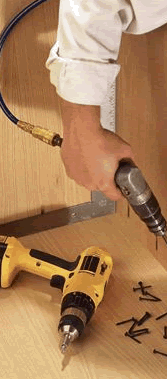-
Sealing
cooling and heating ducts
with duct wrap or mastic sealant can save up to 25% on your
energy bill.
-
Fix
plumbing leaks.
A single drippy faucet can waste 212 gallons of water a
month.
-
Insulate your hot water heater.
Doing so can cut your home's CO2 emissions and save you
around 4% to 9% in water heating costs. You also reduce
standby heat costs by 25%-45%. To see if you need to insulate,
touch your heater. If it's warm to the touch, it needs additional
insulation.
-
Replace
shower heads
with low-flow heads and replace faucets or just the aerators.
Low-flow shower heads can save you between 10% to 16% of
water heating costs and reduce your water usage by 20,000
gallons per year.
-
Install
low flow toilets.
This will save you 3.5 gallons per flush.
-
Install
ceiling fans.
This will cut air conditioning costs by 40% in summer. Alternatively,
in the winter, these ceiling fans work to circulate warm
air from the ceiling back down to the floor to save heating
cost.
-
Plug
overlooked energy leaks around the house!
Use low VOC caulk and foam strips around windows and door
frames that leak air. Add door sweeps and door shoe gaskets.
A 1/8" space around your door is like having a brick
size hole in your wall. Imagine one of these for every door
in the house! Did you know that your light switches can
be an overlooked source of air leaks? Hold a wet hand in
front of a light switch plate or outlet and if you feel
air, you have a leak. Installing foam gaskets behind all
the light switches and outlets can stop these energy leaks.
-
Insulate.
For maximum energy efficiency, your home should be properly
insulated from the roof down to its foundations.
Install a hot water heater timer. if you have an electric
water heater which can turn hot water off at night and on
again in the morning.
-
Replace
your light bulbs.
Energy efficient compact fluorescent bulbs last 8 to 12
times longer than incandescent. Just one bulb alone can
save at least $30 in electric bills over its lifespan and
reduce greenhouse emissions from power plants. Just 5 bulbs
could save you 50% of your annual lighting bill.
-
Replace
old windows
with new high performance dual pane windows with low-e coatings.
Or self-adhesive reflective film on the windows. These films
reduce air conditioning bills. In addition, reflective film
can eliminate interior upholstery fading by blocking harmful
UV rays.
-
Insulating
your hot water pipes.
Not only does this raise the temperature with a lower water
temperature setting, you also conserve water since you don’t
have to wait as long for warm water whenever you turn on
a faucet or a shower! Or install a hot water recirculating
pump and get almost instant hot water every time you take
a shower.
-
Install
outdoor solar lighting.
It's easy to install and virtually maintenance free. Best
of all, it provides free electricity.
-
Install
shades, drapes, awnings or sunscreens
to block light on hot sunny days and keep cooling costs
down. In colder times, closing these drapes can retain warm
air. This may seem like an old-fashioned and low tech, but
it's surprisingly effective and time-tested tactic.
-
Add
lighting controls and timers.
Motion detectors outside can increase security and decrease
energy expenditure. Timers can be set to turn lights off
and on and predetermined times. This is an easy energy saver.
-
Reuse
and Recycle.
How about donating perfectly good cabinets, sinks and other
appliances? Get a tax write-off, help someone else in need
and save room in the landfill – a win win situation. Check
your local listings or go to www.habitat.org for a Habitat
For Humanity Reuse Store in your area
In many cases, you will save more on your energy bill by
making these changes than you will spend on making them!
According
to the U.S. Dept. of Energy, households can save 20%-30% on
energy bills by implementing these improvements. Call us at
702-604-6236 for service.
Stats
provided by U.S. Dept of Energy
We
appreciate the opportunity to work with you and will treat
your home with the same respect and care that we treat our
own.

